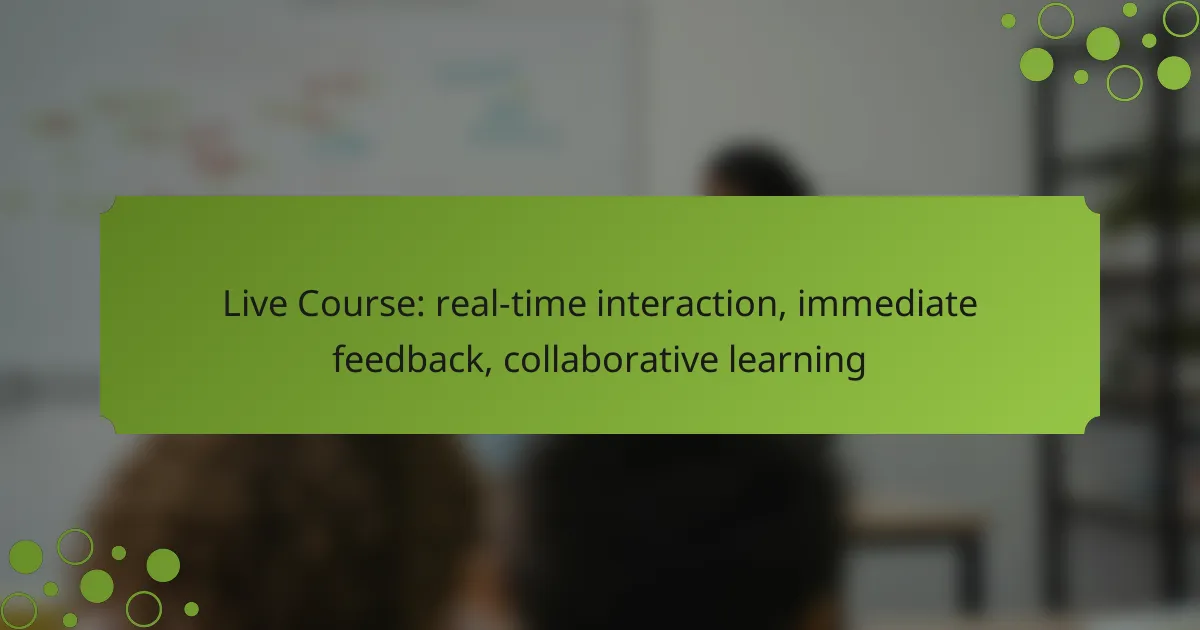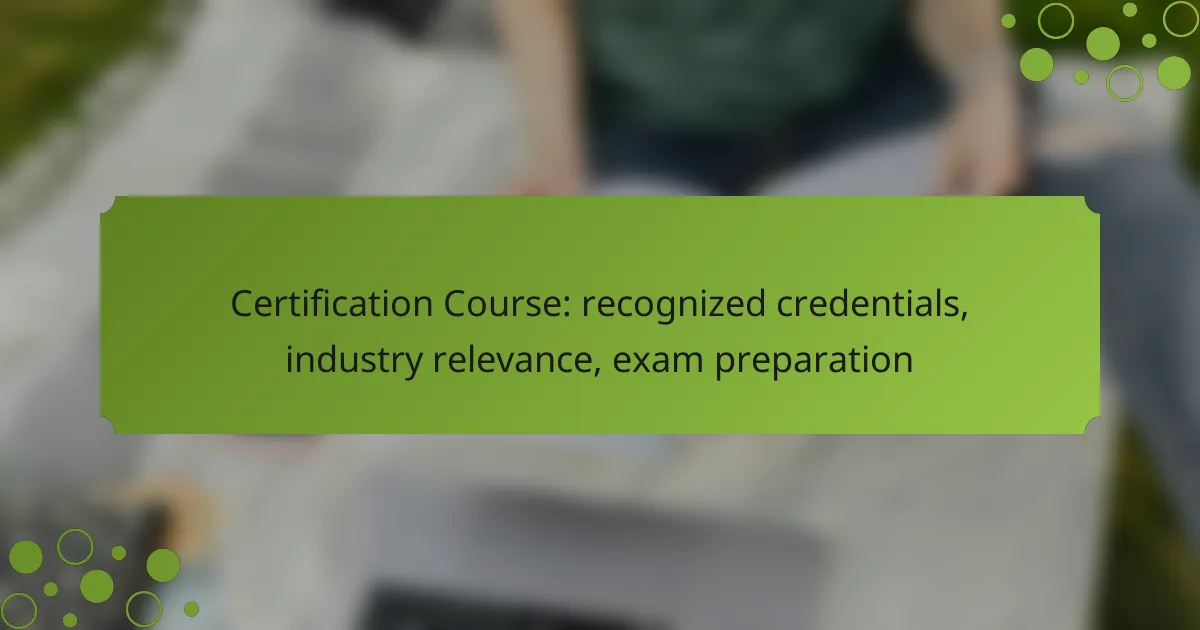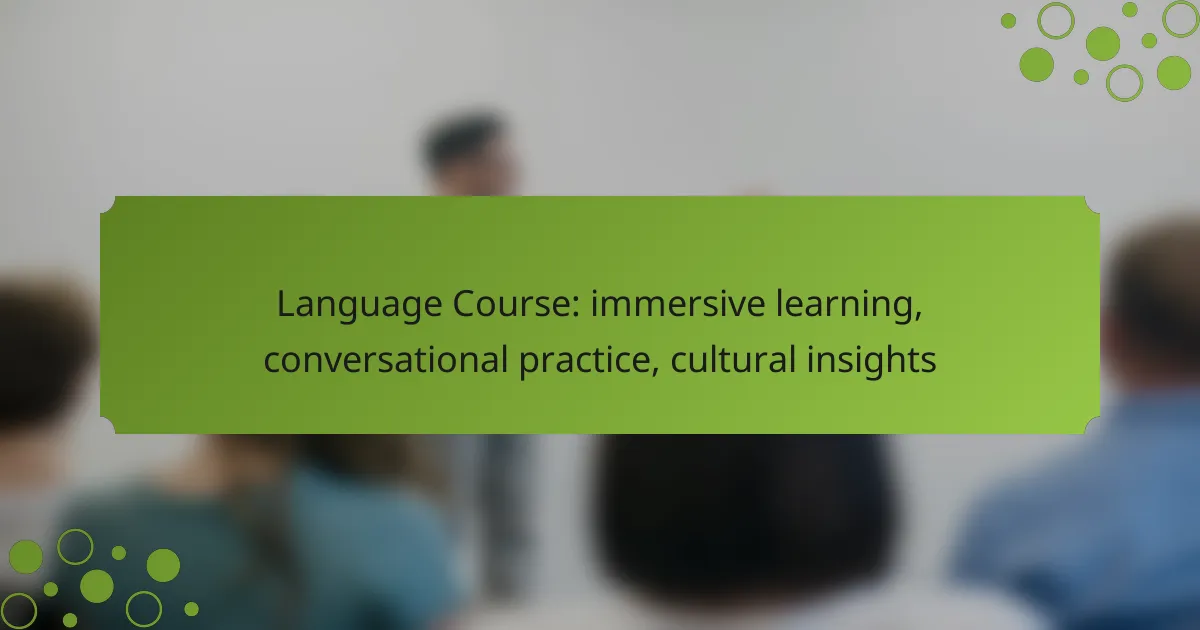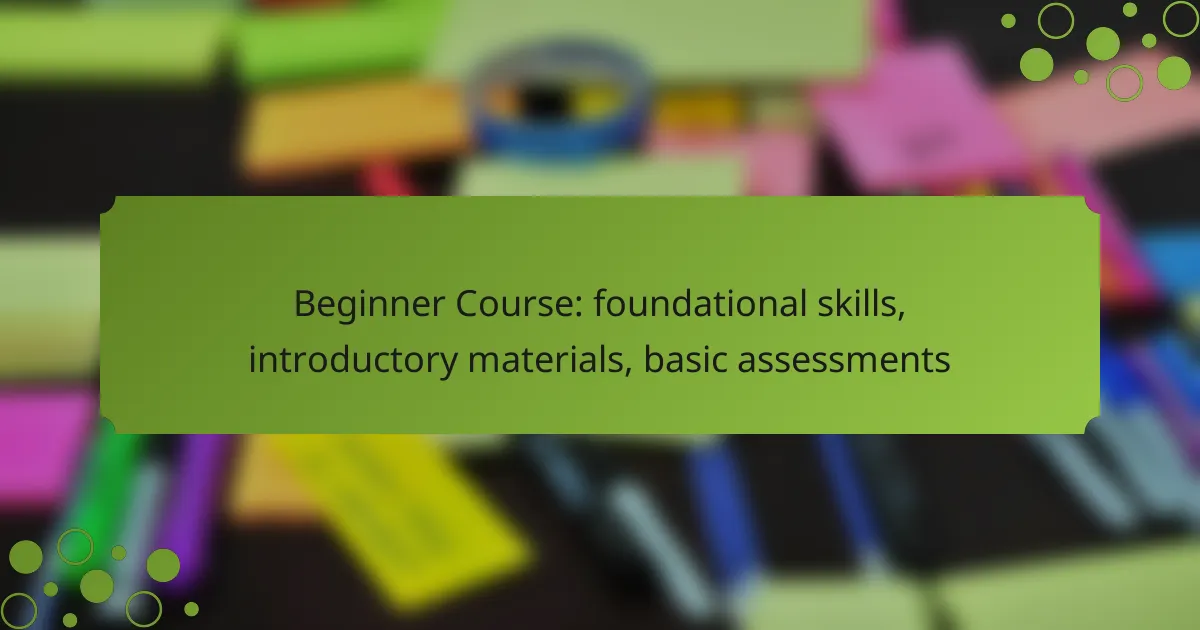Live courses offer a unique opportunity for real-time interaction, enabling participants to engage actively and collaborate effectively. With immediate feedback, students can clarify concepts and reinforce their understanding, fostering a richer educational experience. These dynamic environments encourage collective problem-solving and idea sharing, making learning more engaging and impactful.

How do live courses enhance collaborative learning in Canada?
Live courses significantly enhance collaborative learning in Canada by fostering real-time interaction among participants, allowing for immediate feedback and collective problem-solving. This dynamic environment encourages students to engage actively, share ideas, and learn from one another, creating a richer educational experience.
Real-time discussions
Real-time discussions in live courses facilitate immediate dialogue between students and instructors, promoting a vibrant exchange of ideas. Participants can ask questions and receive answers on the spot, which helps clarify concepts and deepen understanding. This immediacy is particularly beneficial in a Canadian context, where diverse perspectives can enrich discussions.
To maximize the effectiveness of real-time discussions, set clear guidelines for participation. Encourage all students to contribute, and consider using tools like chat features or breakout rooms to ensure everyone has a voice. This approach can help maintain engagement and foster a sense of community.
Group projects
Group projects in live courses allow students to collaborate on tasks, enhancing their teamwork skills and collective learning. These projects often require participants to divide responsibilities, share resources, and integrate their findings, which mirrors real-world work environments. In Canada, this collaborative approach can reflect the multicultural nature of the workforce.
When organizing group projects, consider using online collaboration tools such as Google Workspace or Microsoft Teams. These platforms enable seamless communication and document sharing, making it easier for groups to work together effectively, regardless of their physical locations.
Peer feedback mechanisms
Peer feedback mechanisms in live courses encourage students to evaluate each other’s work, providing constructive criticism and diverse perspectives. This practice not only helps learners improve their projects but also cultivates critical thinking and self-reflection skills. In Canada, where collaborative learning is emphasized, peer feedback can be a vital component of the educational process.
To implement effective peer feedback, establish clear criteria for evaluation and provide training on giving constructive feedback. Encourage students to focus on specific aspects of their peers’ work, such as clarity, creativity, and adherence to guidelines. This structured approach can enhance the quality of feedback and foster a supportive learning environment.

What are the benefits of immediate feedback in live courses?
Immediate feedback in live courses enhances the learning experience by allowing students to receive real-time responses to their questions and actions. This instant interaction helps clarify concepts, correct misunderstandings, and reinforce knowledge effectively.
Enhanced learning retention
Immediate feedback significantly boosts learning retention by reinforcing concepts as they are taught. When students receive prompt responses, they can quickly adjust their understanding and solidify their knowledge, leading to better long-term recall.
For example, if a student answers a question incorrectly during a live session, immediate correction helps them grasp the concept before moving on. This approach is more effective than waiting for delayed feedback, which can lead to confusion and gaps in understanding.
Quick clarification of doubts
Live courses facilitate quick clarification of doubts, allowing students to ask questions and receive answers on the spot. This immediacy prevents misconceptions from taking root and encourages a more interactive learning environment.
In a traditional classroom setting, students may hesitate to voice their uncertainties. However, in a live course, the dynamic nature encourages participation, leading to a more thorough understanding of the material.
Motivation and engagement
Immediate feedback fosters motivation and engagement among learners by creating a responsive learning atmosphere. When students see their progress in real-time, they are more likely to stay engaged and invested in the learning process.
Incorporating gamification elements, such as instant quizzes with immediate results, can further enhance motivation. This approach not only makes learning enjoyable but also encourages students to actively participate and strive for improvement.

Which platforms offer live courses with real-time interaction?
Several platforms provide live courses that facilitate real-time interaction, allowing participants to engage actively and receive immediate feedback. These platforms are designed to enhance collaborative learning experiences through features like video conferencing, chat, and shared resources.
Zoom for Education
Zoom for Education is widely used for live courses due to its user-friendly interface and robust features. It supports up to several hundred participants in a single session, making it suitable for both small classes and larger lectures.
Key features include breakout rooms for group work, screen sharing, and a chat function for real-time questions. Educators can record sessions for future reference, which is beneficial for students who may need to review material.
To maximize engagement, instructors should encourage participation through polls and Q&A sessions. Avoid technical jargon to ensure all students can follow along easily.
Google Meet
Google Meet offers a straightforward platform for live courses, integrating seamlessly with Google Workspace tools. This makes it easy for educators to share documents and collaborate in real-time, enhancing the learning experience.
Meet allows for live captions and has a participant limit that accommodates a medium-sized class effectively. The platform’s security features, such as encryption, ensure a safe environment for learners.
Instructors should utilize the screen sharing feature to present materials clearly and engage students by asking questions throughout the session. Regularly check in with participants to maintain interaction.
Microsoft Teams
Microsoft Teams is another strong contender for live courses, particularly for organizations already using Microsoft 365. It combines video conferencing with collaborative tools, allowing for a comprehensive learning environment.
Teams supports features like file sharing, integrated chat, and the ability to create channels for specific topics or groups. This can help keep discussions organized and focused.
To foster collaboration, educators should encourage students to use the chat feature for questions and discussions. Regular feedback sessions can help identify areas where students may need additional support.

What prerequisites should learners consider for live courses?
Before enrolling in live courses, learners should consider technical requirements, time commitment, and any necessary course prerequisites. These factors can significantly impact the effectiveness and overall experience of participating in real-time interactions and collaborative learning.
Technical requirements
To participate in live courses, learners need a reliable internet connection, preferably broadband, to ensure smooth streaming and interaction. A computer or tablet with a functioning webcam and microphone is essential for engaging in discussions and activities.
Additionally, learners should familiarize themselves with the specific online platform used for the course, whether it’s Zoom, Microsoft Teams, or another service. Checking system compatibility and software updates beforehand can prevent technical issues during sessions.
Time commitment
Live courses typically require a significant time commitment, often ranging from a few hours per week to several hours each day, depending on the course length and structure. Learners should review the course schedule to plan their availability accordingly.
It’s also important to allocate time for preparation and follow-up activities, such as reviewing materials or completing assignments. Balancing these commitments with other responsibilities is crucial for a successful learning experience.
Course prerequisites
Many live courses have prerequisites that learners must meet before enrollment, such as prior knowledge or skills in a related subject area. Reviewing these requirements can help ensure that participants are adequately prepared to engage with the course content.
Some courses may also recommend specific resources or introductory materials to help learners build a foundational understanding. Taking the time to complete these prerequisites can enhance participation and collaboration during live sessions.

How do live courses compare to traditional online courses?
Live courses offer real-time interaction and immediate feedback, setting them apart from traditional online courses that typically rely on pre-recorded content. This dynamic environment fosters collaborative learning, enhancing student engagement and comprehension.
Interaction levels
In live courses, interaction occurs in real-time, allowing students to ask questions and participate in discussions immediately. This contrasts with traditional online courses, where interaction may be limited to forums or scheduled Q&A sessions, often leading to delays in communication.
For example, platforms like Zoom or Microsoft Teams enable instant dialogue, making it easier for learners to engage with instructors and peers. This high level of interaction can significantly boost motivation and retention of information.
Feedback speed
Immediate feedback is a hallmark of live courses, as instructors can address misconceptions and provide guidance on the spot. In traditional online courses, feedback may take days or even weeks, which can hinder a learner’s progress and understanding.
For instance, in a live setting, an instructor can clarify a concept during the session, while in a traditional course, a student might have to wait for an instructor’s response to a posted question. This swift feedback loop is crucial for effective learning.
Learning outcomes
Live courses often lead to improved learning outcomes due to their interactive nature and immediate feedback mechanisms. Studies suggest that students in live environments tend to perform better on assessments compared to those in traditional formats.
Additionally, the collaborative aspect of live courses encourages peer learning, where students can share insights and support each other. This can enhance critical thinking and problem-solving skills, which are essential for real-world applications.
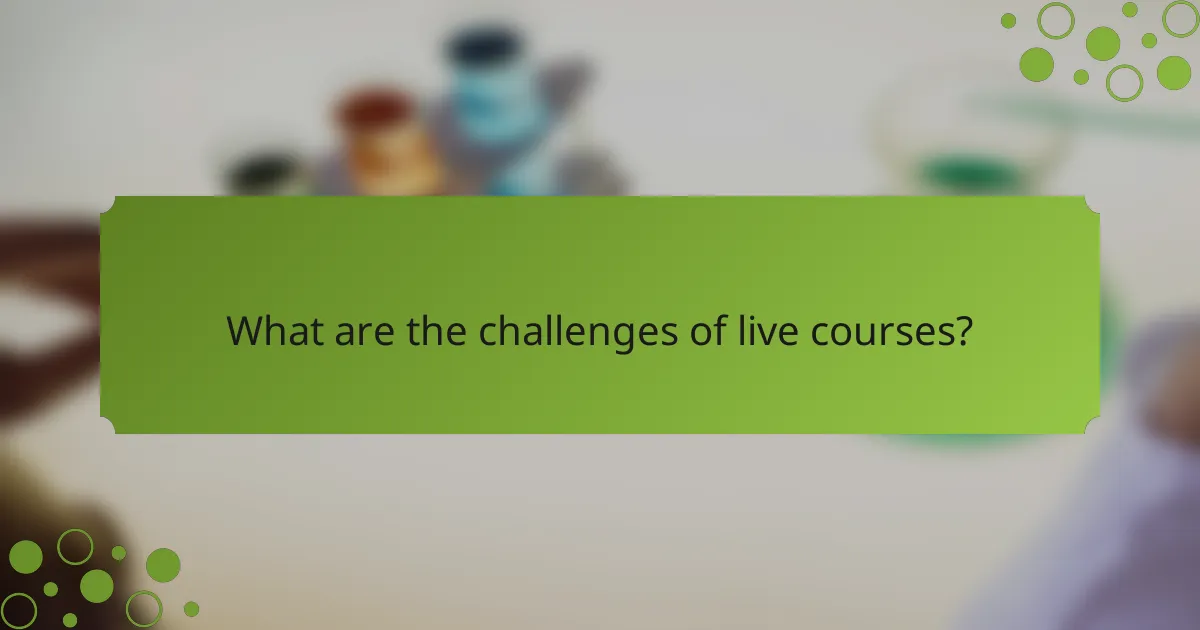
What are the challenges of live courses?
Live courses present several challenges that can impact the learning experience, including time zone differences, technical issues, and participant engagement. Addressing these challenges is crucial for maximizing the effectiveness of real-time interaction and collaborative learning.
Time zone differences
Time zone differences can significantly affect participation in live courses, especially when attendees are spread across various regions. Scheduling sessions that accommodate all participants can be challenging, often requiring compromises that may not suit everyone.
To mitigate this issue, consider rotating session times or offering multiple live sessions for the same content. This approach allows participants to choose a time that works best for them, enhancing accessibility and engagement.
Technical issues
Technical issues, such as poor internet connectivity or software glitches, can disrupt the flow of live courses. These problems can lead to frustration among participants and hinder effective communication and collaboration.
To minimize technical disruptions, ensure that all participants have access to reliable technology and provide clear instructions for using the platform. Conducting a test session before the actual course can help identify potential issues and allow for troubleshooting.
Participant engagement
Maintaining participant engagement during live courses can be challenging, particularly in a virtual environment where distractions are prevalent. Engaged participants are more likely to absorb information and contribute to discussions.
Incorporate interactive elements such as polls, breakout rooms, and Q&A sessions to foster engagement. Additionally, encourage participants to share their experiences and insights, creating a collaborative learning atmosphere that keeps everyone involved.
